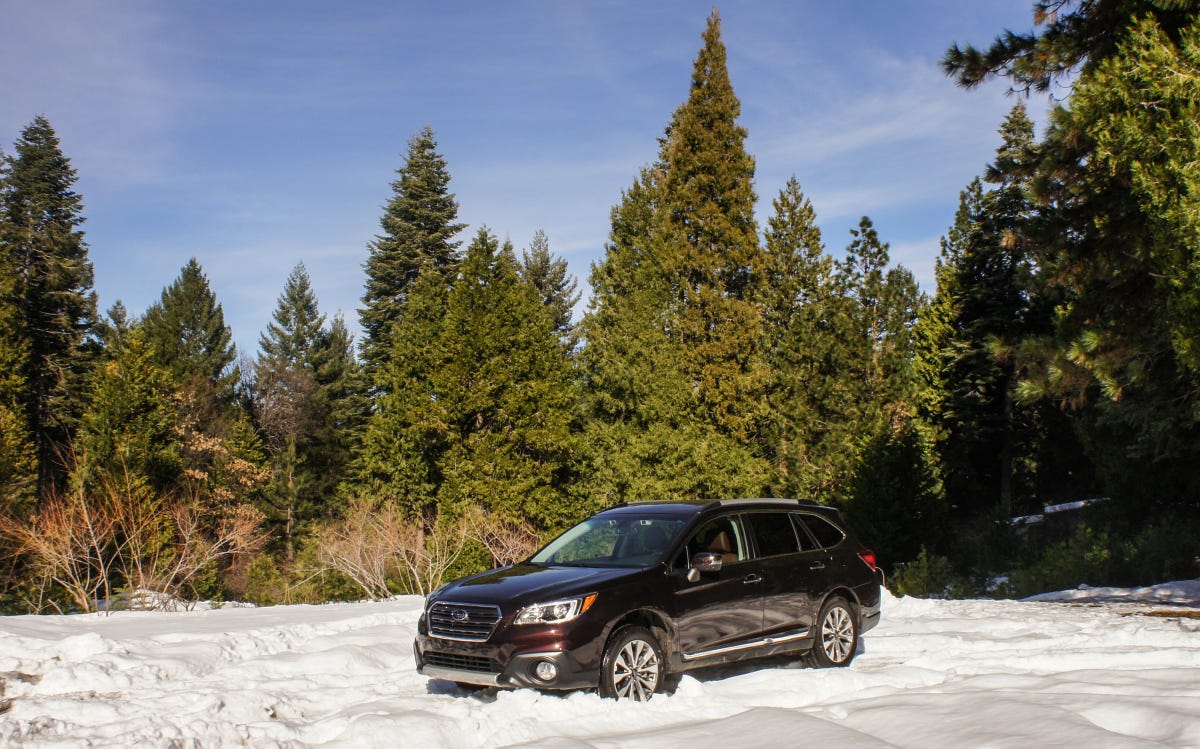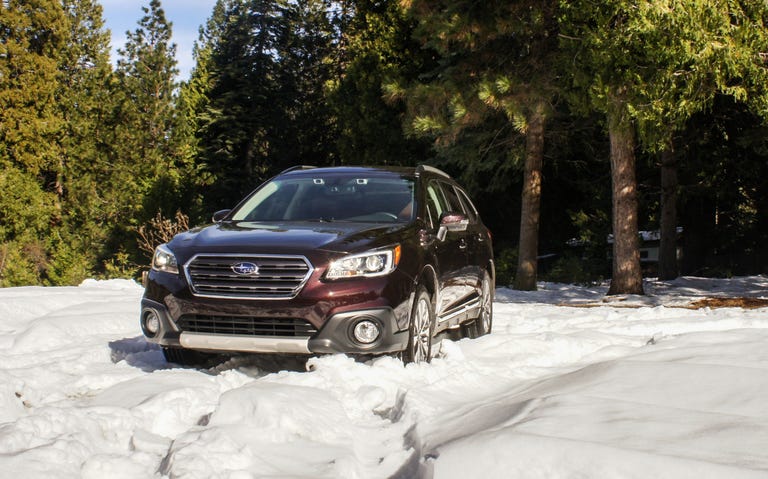 Why You Can Trust CNET
Why You Can Trust CNET 2017 Subaru Outback review: Despite drivetrain changes, Outback still a powder hound
With 8.7-inches of ground clearance, standard all-wheel drive and virtual gears for its continuously variable transmission, the Subaru Outback remains capable on slippery surfaces.
Subaru enjoys a reputation for offroad-capable cars, but I still managed to get the 2017 Outback stuck in the snow. Although its crossover SUVs still come standard with all-wheel-drive, Subaru made some changes to its drivetrains over the past couple of years, such as replacing gearboxes with continuously variable transmissions (CVTs) and adding what it calls X-Mode, a traction control and throttle program designed for slippery surfaces.
The Good
The Bad
The Bottom Line
I know, it's a poor craftsman who blames his tools, but here's the scenario: People who live in snow country favor Subarus, so for my review, I followed some tire tracks into about a foot-deep uncleared snow pack in a parking lot. The Outback handled it well, but then I got to a point where the tires lost traction and the car wouldn't go forward. A little reverse, then a little forward, and nothing, not even wheel spin. I was stuck.
Engaging X-Mode, the Outback still couldn't get out. Looking around outside, the Outback's 8.7-inches of ground clearance kept the body off the snow, so the stock Bridgestone Dueler H/P Sport tires were making full contact with the ground. Some combination of CVT and drive program refused to put power to the wheels in this low-traction situation.

The Outback's 8.7-inches of ground clearance keeps it from getting high-centered in moderate snow.
Saving the Outback, and myself from a towing fee, Subaru had the foresight to give the CVT a manual mode, programmed shift points that simulate fixed gears. Putting the Outback into virtual first gear, all four wheels got the power they needed to pull through, and I was home free.
The Outback vies with the Forester for the top sales spot in Subaru's line-up, achieving success with its crossover functionality, giving it a high riding position, seating for five and useful cargo space. Subaru reliability and standard all-wheel drive are points in its favor. This practical car serves well as a family vehicle.
The 2.5i Touring version I reviewed loads on the amenities while remaining frugal on fuel consumption. Its 2.5-liter four cylinder engine, in Subaru's standard flat four configuration, makes 175 horsepower and 174 pound-feet of torque, while achieving 25 mpg in the city and 32 mpg on the highway, according to EPA testing. Through a mix of city and freeway driving, my average came in at 26 mpg.
The cabin will likely surprise long-time Subaru fans, and it certainly impressed me with its satin-finish wood trim and saddle brown leather, in a color Subaru calls java brown. This coachwork comes courtesy of the Outback's new Touring trim, also loaded with dashboard electronics and driver-assistance features.
Subaru gives the Outback a premium treatment with satin finish wood trim.
Subaru tends to be a follower, not a leader, when it comes to dashboard tech, which shows in the Outback's navigation system. This head unit offers basic navigation, digital audio and Bluetooth phone support, all accessible on a modest 7-inch touchscreen. I found the touch response times reasonable, and never needed to double-tap the screen.
Although online destination search does not appear in the navigation menu, the Outback offers some limited search through its integration with the Aha app. And for that rare person with a MirrorLink-capable phone, the Outback will mirror the phone's apps on its own touchscreen. For emergency services and other on-the-road needs, Subaru includes its StarLink telematics system, along with an associated app. The Outback doesn't offer Apple CarPlay or Android Auto, but that should be coming soon, as both the 2017 Impreza and 2018 Legacy support those features.
What really enhanced my driving pleasure was the Outback's Harmon Kardon stereo, also standard in Touring trim, which features 12 speakers and a 576-watt amp.
In active safety, the Outback doesn't slouch, as its excellent EyeSight system enables pre-collision braking and lane-departure warning. It beeped at me a few times when it sensed I was approaching stopped traffic too quickly, but never needed to apply the brakes for me. I got more use out of its adaptive cruise control, which brakes the car to match speeds of slower traffic ahead.
While this camera-based system worked reasonably well day and night, I felt it was a little slow to begin braking as I approached stopped traffic on the freeway. The first time I encountered this situation, I felt the need to take over braking myself, but on another occasion I let it do its thing, and it stopped in time. EyeSight also worked in stop-and-go traffic, taking some of the stress out of slow driving.
The ease added to driving the Outback by EyeSight reflects my overall experience with the car. Its crossover body style enhanced cabin accessibility, a virtual invitation to get in and drive. Push the start button, pull the parking brake button and jam the console lever into Drive. Electric power assist on the steering feels well-tuned, delivering a natural and direct response. The Outback supports a get-in-and-go lifestyle, a helper rather than a hindrance to travel.
Subaru gained much of its US brand identity from owners who enjoy nature and outdoor recreation.
That ease of driving means that In normal situations, on the freeway and city streets, the Outback won't particularly engage the driver. The reasonably comfortable ride and non-twitchy steering make it seem like a bit of a dog. The modest 175 horsepower from the four-cylinder engine and the CVT don't exactly create excitement, and so-so acceleration left me wondering how it might behave on an ascent in the mountains while hauling a snowboarding group.
However, the Outback keeps a trick or two up its fender. Pushing it a little bit on a twisty road, I felt assisted rotation in the turns. Poring over the spec sheet, I saw that Subaru programmed in what it calls Active Torque Vectoring. As with other Subaru models, this phrase means the car applies minor braking to the inside wheels in a turn, just enough so the outside wheels push it around. Not only does this system help handling, but it should also increase safety.
There isn't much help for the lack of power from the four-cylinder, but Subaru does offer a 3.6-liter six-cylinder engine. At 256 horsepower, that engine will give more satisfying acceleration, and makes a good option for people who want to take advantage of the Outback's 2,700 pound tow rating. However, the six cylinders means a 5 mpg decrease in fuel economy.
Crossover SUVs have become extremely popular, so the Outback faces many worthy competitors.
The 2017 Subaru Outback continues this model's reign as one of the more practical and capable crossovers, showing up the competition with its standard all-wheel-drive. The ease of driving works in its favor, as does the EyeSight system, although most other crossovers can be optioned with their own advanced safety features. The dashboard electronics are on par with some, but fall behind others.
The new Touring trim gives the Outback an upscale style that might keep the upwardly mobile from jumping to a premium brand.
The Outback faces its biggest challenge with the amount of competitors in the field. Although a little smaller, cars such as the Ford Escape, Toyota RAV4 and Honda CR-V hit the top 10 in US sales charts, and offer all-wheel-drive, economical engines and advanced electronics. Among more size-equivalent cars, the Nissan Murano comes in with more urban-oriented style, while the Ford Edge feels more suburban. Edging over to the Toyota Highlander and Honda Pilot, these cars benefit from third-row seating, something not offered in the Outback.


